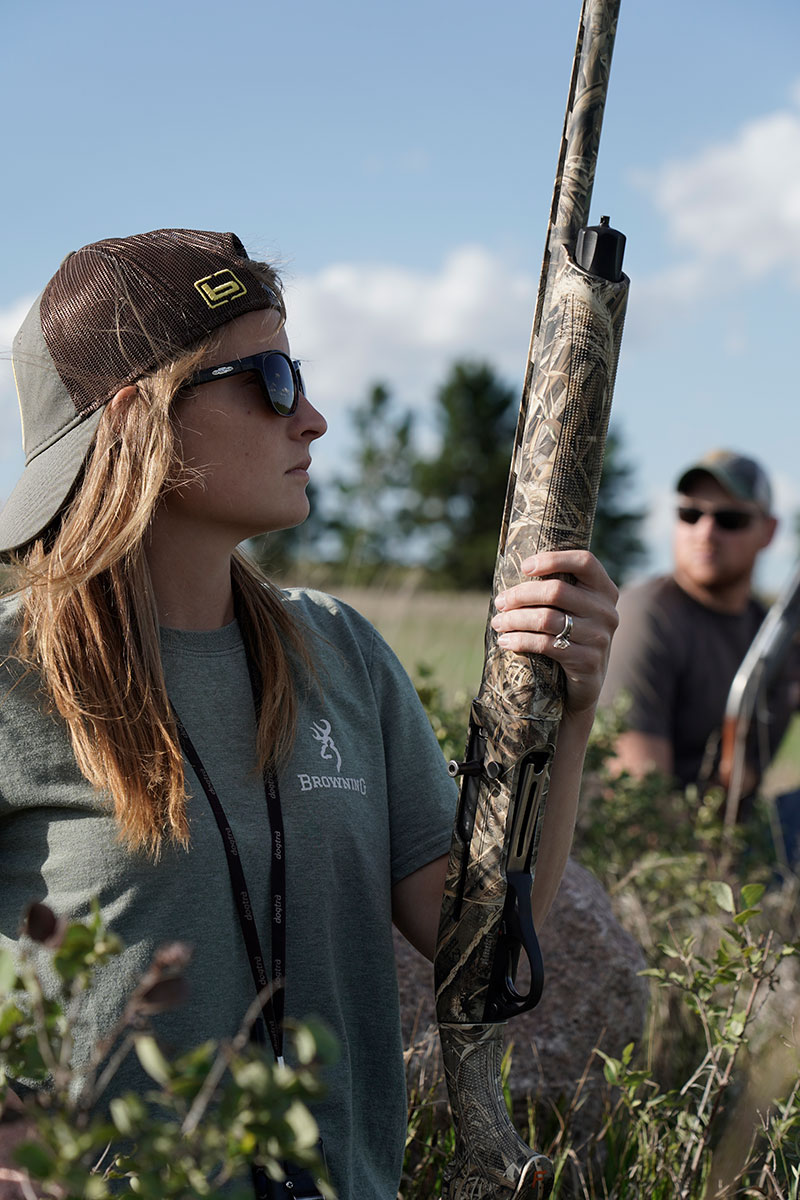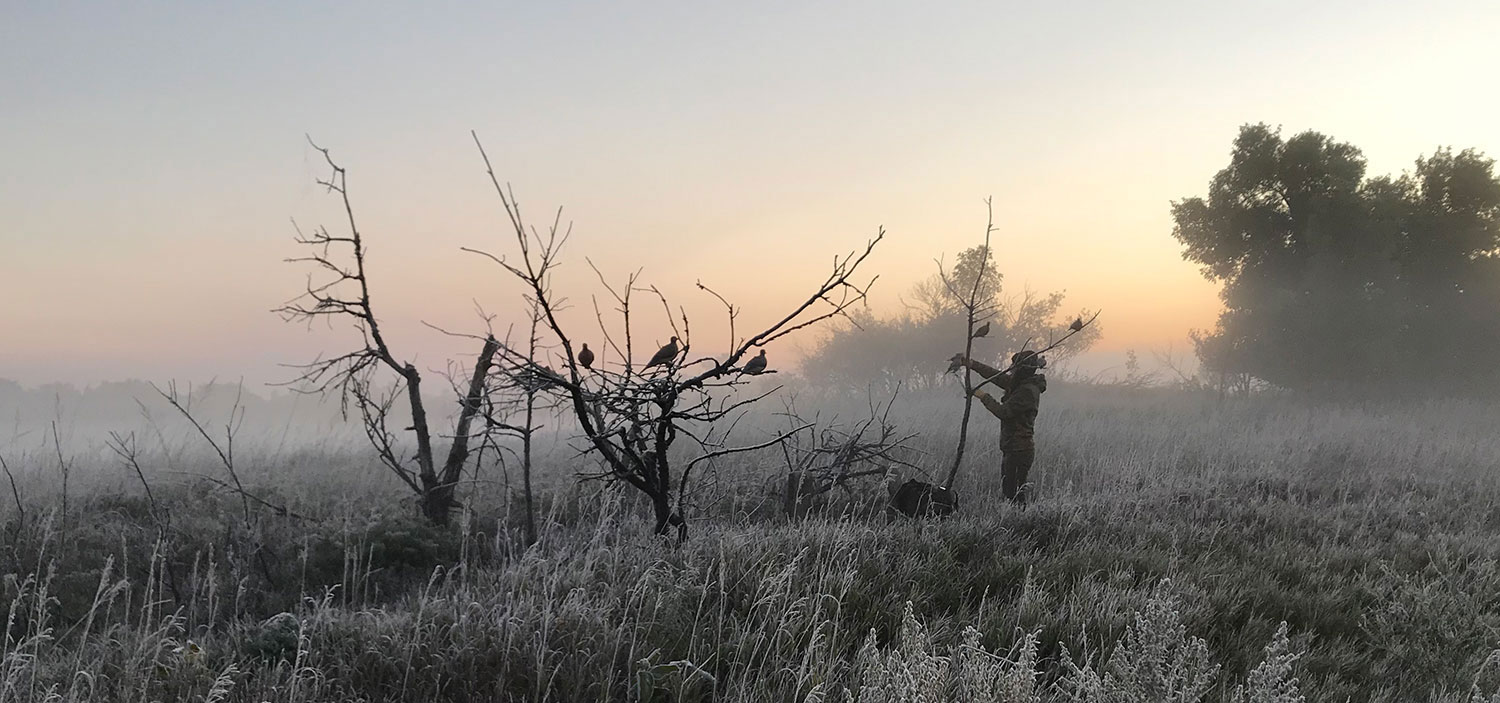A Jumpstart to Fall
Cayla Bendel

It’s been a long summer, the heat and wind relentless. Crisp, still mornings in a tree stand or chilly evenings walking the prairie are still daydreams, but it’s the first full week of September signifying dove hunting is open and at its prime.
In southern parts of the country and elsewhere, dove opener elicits the same thrill and accompanying pageantry as North Dakota’s deer opener, but for whatever reason it’s often an overlooked and underutilized resource in this neck of the prairie. Fortunately, because of this, competition to hunt these speedy migrants is usually minimal and access abundant, even on private land if you’re willing to ask.
Walking With Purpose
Finally, my after-work walks with Fins have an aim again. Monday, we set off on our own to a wildlife management area that has produced doves in the past. I’m unsure what’s been planted in the food plots this year, so my plan is to simply walk around, shotgun in hand, and see if I can’t stumble into a good place to setup for an hour or so. Finley, however, has other plans. He takes off into the corn field and is locked on point just minutes into our walk. I roll my eyes as I make my way through the jungle of stalks to flush the bird, a hen pheasant. He barks with excitement as he notoriously tends to do. I urge him back to the plan.
We continue like this for about a half-hour without running into a single dove before I decide to setup two battery-powered spinning wing decoys and just wait ... to no avail. I pack up the decoys, shoulder my frustration and take the long way back to the parking area still hoping to find a few birds that always give themselves away with the tell-tale whistling sound revealed during flight.
Fins wades the cattail edges hoping the flocks of ducks don’t hear or see him approaching. We come up empty handed, but both of us leave with some sort of renewed purpose that only comes with the onset of fall.
Birthday Birds
It’s Tuesday, my birthday. I meet coworkers at some private land outside of town near a drought-hazed cornfield that supports a much better crop of weeds. We setup decoys and spread out. Contrary to yesterday, doves buzz by consistently throughout the evening. The stack of birds grows, little thanks to me and my growing pile of spent shells but we laugh at misses and interrupt side conversations to announce incoming birds.
At sunset around the tailgate, with dove feathers floating in the wind, my birthday and the start of another fall hunting season is greeted with a hearty “cheers.”

Mocked by Doves
Wednesday, Fins and I head to a wildlife management area along Lake Sakakawea with my husband, Scott. The area is new to us, so we stick to the plan, walk around and see if we can’t find a spot to setup. With little action, we drive farther down the road and spot some doves loafing on a wire fence. We park and setup in a tree row nearby.
The doves mock us from the fence and occasionally fly to the gravel road. We eat the sandwiches I packed, Fins pants in the shade. A few catch us off guard, buzzing by much too quickly for me to even drop my cookie and shoulder my shotgun. Oh well. Fins woofs in his sleep that night.
Sounds of Fall
Friday, we wait for Scott to get off of work to head west for grouse opener but Fins and I sneak in an hour at yet another wildlife management area near town, the one Scott initially recommended, and I stubbornly ignored.
Even from the parking area I can see a single tree with a half-dozen doves in it. We head toward the lone tree and one straggler, a late-to-fly dove meets its demise. Finley brings it to hand and we setup at the base of the tree hoping others will return.
Finley’s ears perk at each flock of ducks that passes overhead and at the distant crow of a rooster pheasant. We enjoy another hour together listening to the start of fall, clean and pack our few doves.
Whether it’s a solo endeavor, the camaraderie of friends, family, or coworkers that feel like both, a Tupperware sandwich date night, or simply a chance to sharpen your shooting for other pursuits, dove season offers the perfect start to hunting season. All week I’ve watched the pep in Fins step and the twinkle in his eyes that I haven’t seen in months, and that was reward enough. I imagine, even after all that missing at fast-flying birds, there’s a twinkle in mine too. It’s back.

Tips for Dove Hunting
- Localized areas that tend to have more doves are landscapes with a combination of trees, pasturelands, hay lands, croplands and water sources. When it comes to crops, wheat, barley, canola and sunflowers are best, but sometimes doves use odd areas along the edges of corn and soybean fields.
- In North Dakota, dove season opens September 1, but doves will migrate south when the weather turns cold, so usually the best dove hunting is during the first week of September.
- Recommended shot sizes for doves are 7, 71/2 and 8. Purchase ammunition sooner rather than later as it may be hard to come by during hunting season.
- Dove hunting can involve a lot of missing, so don’t be discouraged if there’s more missing than hitting — that’s normal. Bring a couple of boxes of shells when you go.
- Doves can be difficult to find once downed due to their small size and neutral grey color. Only drop birds into heavy cover if you are using a dog to assist in retrieval.
- Like any migratory game bird, doves might be carrying a metal leg band. If you harvest any birds with bands, report the band numbers at: reportband.gov.
- Never shoot at doves sitting on powerlines or other objects — it is not safe, and in some cases, illegal.
- Doves are great table fare, and three to four birds make the right portion for the average person, but weather conditions can be hot when dove hunting so be sure to get your birds cleaned soon after hunting.
